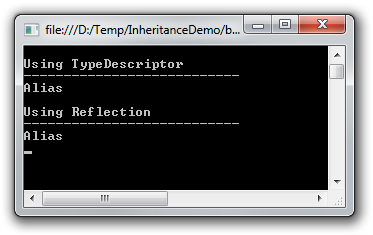Interface Inheritance Esoterica
I learned something new yesterday about interface inheritance in .NET as compared to implementation inheritance. To illustrate this difference, here’s a simple demonstration.
I’ll start with two concrete classes, one which inherits from the other. Each class defines a property. In this case, we’re dealing with implementation inheritance.
public class Person {
public string Name { get; set; }
}
public class SuperHero : Person {
public string Alias { get; set; }
}
We can now use two different techniques to print out the properties of
the SuperHero type: type descriptors and reflection. Here’s a little
console app that does this. Note the code I’m showing below doesn’t
include a few Console.WriteLine calls that I have in the actual app.
static void Main(string[] args) {
// type descriptor
var properties = TypeDescriptor.GetProperties(typeof(SuperHero));
foreach (PropertyDescriptor property in properties) {
Console.WriteLine(property.Name);
}
// reflection
var reflectedProperties = typeof(SuperHero).GetProperties();
foreach (var property in reflectedProperties) {
Console.WriteLine(property.Name);
}
}
Let’s look at the output of this code.

No surprises there.
The SuperHero type has two properties, Alias defined on SuperHero
and the Name property inherited from its base type.
But now, let’s change these classes into interfaces so that we’re now
dealing with interface inheritance. Notice that ISupeHero now
derives from IPerson.
public interface IPerson {
string Name { get; set; }
}
public interface ISuperHero : IPerson {
string Alias { get; set; }
}
I’ve also made the corresponding changes to the console app.
var properties = TypeDescriptor.GetProperties(typeof(ISuperHero));
foreach (PropertyDescriptor property in properties) {
Console.WriteLine(property.Name);
}
// reflection
var reflectedProperties = typeof(ISuperHero).GetProperties();
foreach (var property in reflectedProperties) {
Console.WriteLine(property.Name);
}
Before looking at the next screenshot, take a moment to answer the question, what is the output of the program now?
 Well it should be obvious that the output is different otherwise I
wouldn’t be writing this blog post in the first place, right?
Well it should be obvious that the output is different otherwise I
wouldn’t be writing this blog post in the first place, right?
When I first tried this out, I found the behavior surprising. However, it’s probably not surprising to anyone who has an encyclopedic knowledge of the ECMA-335 Common Language Infrastructure specification (PDF) such as Levi, one of the ASP.NET MVC developers who pointed me to section 8.9.11 of the spec when I asked about this behavior:
8.9.11 Interface type derivation Interface types can require the implementation of one or more other interfaces. Any type that implements support for an interface type shall also implement support for any required interfaces specified by that interface. This is different from object type inheritance in two ways:
- Object types form a single inheritance tree; interface types do not.
- Object type inheritance specifies how implementations are inherited; required interfaces do not, since interfaces do not define implementation. Required interfaces specify additional contracts that an implementing object type shall support.
To highlight the last difference, consider an interface,
IFoo, that has a single method. An interface,IBar, which derives from it, is requiring that any object type that supportsIBaralso support IFoo. It does not say anything about which methodsIBaritself will have.
The last paragraph provides a great example of why the code I wrote
behaves as it does. The fact that ISuperHero inherits from IPerson
doesn’t mean the ISuperHero interface type inherits the properties of
IPerson because interfaces do not define implementation.
Rather, what it means is that any class that implements ISuperHero
must also implement the IPerson interface. Thus if I wrote an
implementation of ISuperHero such as:
public class Groo : ISuperHero {
public string Name {get; set;}
public string Alias {get; set;}
}
The Groo type must implement both ISuperHero and IPerson and
iterating over its properties would show both properties.
Implications for ASP.NET MVC Model Binding
You probably could have guessed this part was coming. Let’s say you’re
trying to use model binding to bind the Name property of an
ISuperHero. Since our model binder uses type descriptors under the
hood, we won’t be able to bind that property for the reasons stated
above.
I learned of this detail investigating a bug reported in StackOverflow. It turns out this behavior is by design. In the context of sending a view model to the view, that view model should be a simple carrier of data. Thus it makes sense to use concrete types on your view model, in contrast to your domain models which will more likely be interface based.
Comments
14 responses